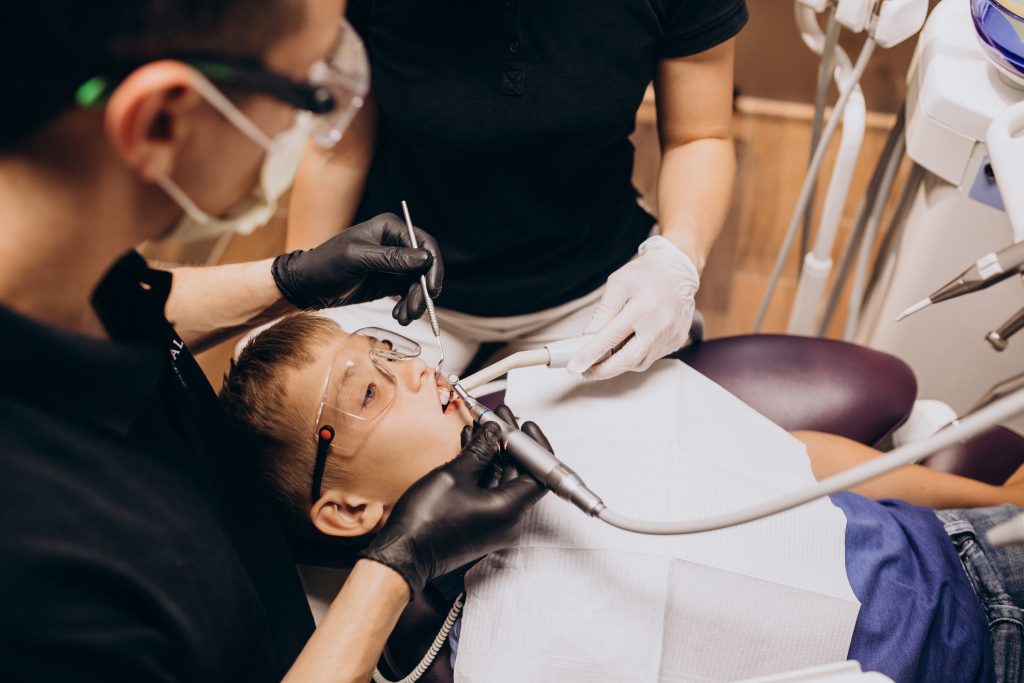
Restorative Dental Care
Restorative dental care focuses on repairing and restoring the function, health, and appearance of children’s teeth. As children grow, they may experience dental issues that require treatment to restore their teeth to full functionality. Whether it’s addressing cavities, tooth decay, or damaged teeth, restorative treatments help preserve the integrity of your child’s teeth and promote long-term oral health.
Restorative Treatments for Kids
1. Tooth-Colored Fillings
Tooth-colored fillings are a preferred treatment for cavities in children. These aesthetic restorations are made from composite resins or other biocompatible materials that blend seamlessly with natural tooth enamel, ensuring a natural-looking result. Tooth-colored fillings are designed to restore the structure and function of teeth while maintaining an attractive, unnoticeable appearance.
Benefits of Tooth-Colored Fillings:
- Aesthetically Pleasing: Unlike metal fillings, tooth-colored fillings blend with the natural color of teeth, making them ideal for treating cavities in visible areas like the front teeth.
- Preserves Tooth Structure: The composite material bonds directly to the tooth, allowing for the preservation of more natural tooth structure compared to traditional metal fillings.
- Durable and Functional: These fillings are durable, functional, and resistant to wear, helping your child’s teeth maintain proper function.
2. Pediatric Dental Crowns
Pediatric dental crowns are custom-made caps that fit over damaged or decayed baby teeth, restoring their strength, shape, and function. Crowns are essential for protecting teeth that have undergone significant damage or decay, ensuring they continue to perform their role in chewing, speaking, and supporting healthy oral development. Pediatric crowns are available in various materials, including stainless steel, porcelain, or resin, and are carefully selected based on the specific needs of the child.
Why Pediatric Crowns Are Important:
- Restore Tooth Function: Crowns restore the function of damaged or decayed teeth, ensuring your child can chew and speak properly.
- Protects Teeth: Crowns cover and protect weakened teeth from further damage, especially for teeth that are prone to breaking or cracking.
- Prevents Premature Tooth Loss: By protecting and strengthening the tooth, crowns help preserve the tooth until it naturally falls out, allowing for proper space maintenance for adult teeth to come in.
3. Pulpotomy (Baby Root Canal)
A pulpotomy, also known as a baby root canal, is a treatment used to save a severely decayed or infected baby tooth by removing the infected pulp from the inside of the tooth. This procedure is typically performed when a cavity or infection reaches the pulp (the soft tissue inside the tooth) but the tooth is still able to be saved. After removing the pulp, the tooth is cleaned, and the remaining space is filled with a special material to protect the tooth until it naturally falls out.
Benefits of Pulpotomy for Kids:
- Pain Relief: Pulpotomy removes the source of infection, alleviating the pain caused by decayed or infected pulp.
- Prevents Premature Tooth Loss: By saving the tooth, the procedure ensures that the baby tooth remains in place until it’s ready to naturally shed, allowing the permanent tooth to erupt properly.
- Preserves Oral Health: By addressing the infection early, pulpotomy prevents the spread of bacteria to surrounding teeth, maintaining overall oral health.
The Importance of Restorative Care for Children
Restorative dental care helps protect your child’s oral health and ensures that their teeth remain strong and functional as they grow. By addressing issues like cavities, tooth decay, and damage promptly, restorative treatments can prevent future complications, such as tooth loss or misalignment.
Benefits of Early Restorative Treatment:
- Maintains Proper Oral Function: By restoring damaged teeth, your child can continue to eat, speak, and smile confidently without difficulty.
- Prevents Future Complications: Early treatment prevents the progression of dental issues that could lead to more extensive and costly procedures later on.
- Supports Long-Term Dental Health: Restorative care helps maintain a healthy environment for permanent teeth, ensuring the best possible foundation for your child’s lifelong dental health.
Restorative dental care plays a critical role in helping your child maintain strong, healthy teeth throughout their childhood years. Early intervention and restorative treatments like tooth-colored fillings, crowns, and pulpotomies are essential for promoting long-term oral health.
Frequently Asked Questions (FYQs)
Q: How can I tell if my child needs a dental crown?
A: Your child may need a dental crown if they have a severely decayed or damaged tooth that cannot be adequately restored with a filling. Crowns are also used to protect teeth after a root canal or pulpotomy.
Q: Are tooth-colored fillings better than silver fillings for children?
A: Tooth-colored fillings are a great choice for children as they blend seamlessly with natural teeth, making them aesthetically preferable, especially for front teeth. They also bond better to the tooth and require less removal of healthy tooth structure compared to silver fillings.
Q: Is pulpotomy painful for my child?
A: Pulpotomy is typically performed under local anesthesia to ensure that your child remains comfortable during the procedure. Afterward, mild discomfort may occur, but it can be managed with over-the-counter pain relievers.
Q: How long do pediatric crowns last?
A: Pediatric crowns are designed to last for several years, depending on your child’s age and the material used. They will protect the tooth until it naturally falls out, allowing for the healthy eruption of adult teeth.
Q: Will my child’s baby tooth eventually fall out after a pulpotomy?
A: Yes, after a pulpotomy, the treated baby tooth will stay in place until it naturally falls out, helping to maintain space for the permanent tooth to emerge.
